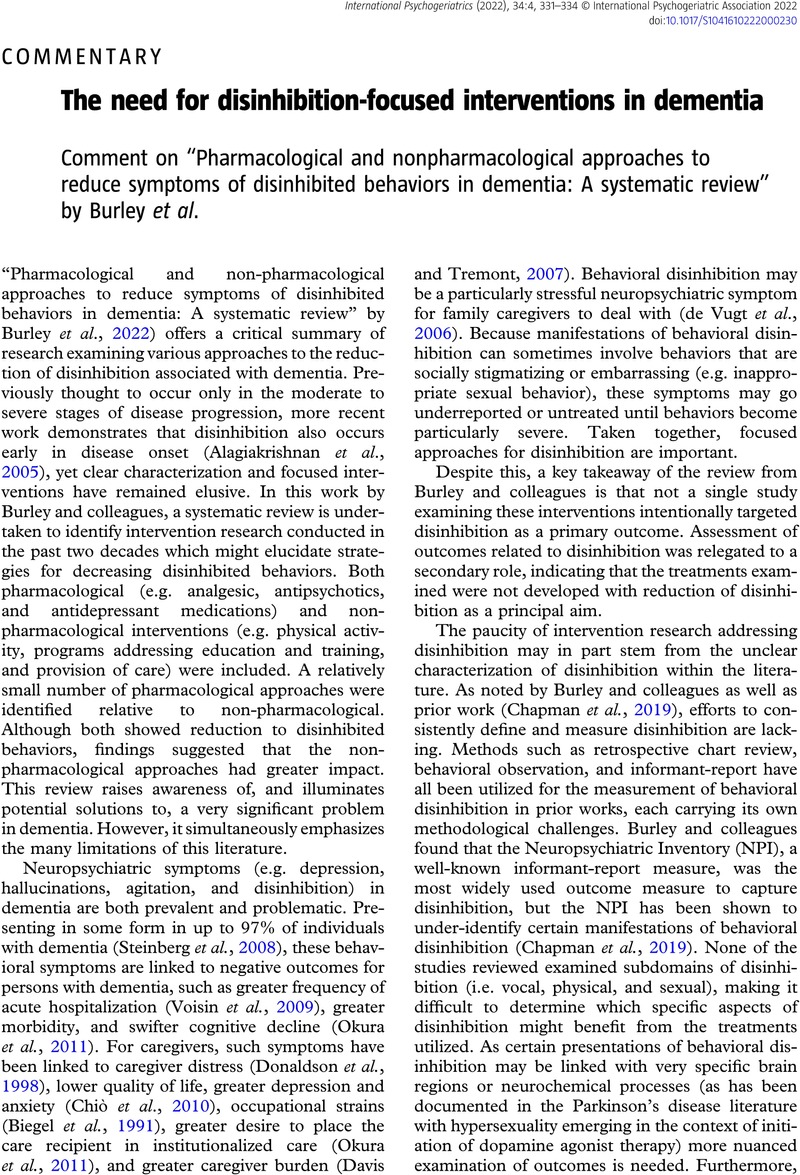No CrossRef data available.
Article contents
The need for disinhibition-focused interventions in dementia
Comment on “Pharmacological and nonpharmacological approaches to reduce symptoms of disinhibited behaviors in dementia: A systematic review” by Burley et al.
Published online by Cambridge University Press: 07 March 2022
Abstract
An abstract is not available for this content so a preview has been provided. Please use the Get access link above for information on how to access this content.

- Type
- Commentary
- Information
- International Psychogeriatrics , Volume 34 , Issue 4: Issue Theme: Varied Facets of Dementia , April 2022 , pp. 331 - 334
- Copyright
- © International Psychogeriatric Association 2022
References
Alagiakrishnan, K., Lim, D., Brahim, A., Wong, A., Wood, A., Senthilselvan, A. (2005). Sexually inappropriate behaviour in demented elderly people. Postgraduate Medical Journal, 81:463–466.CrossRefGoogle ScholarPubMed
Anderson, M., Perrin, A. (2017). Technology Use among Seniors. Pew Research Center. https://www.pewresearch.org/internet/2017/05/17/technology-use-among-seniors/
Google Scholar
Ballard, C., Day, S., Sharp, S., Wing, G. and Sorensen, S. (2008). Neuropsychiatric symptoms in dementia: importance and treatment considerations. International Review of Psychiatry, 20, 396–404. DOI 10.1080/09540260802099968.CrossRefGoogle ScholarPubMed
Biegel, D. E., Sales, E. and Schulz, R. (1991). Family Caregiving in Chronic Illness: Alzheimer’s Disease, Cancer, Heart Disease, Mental Illness, and Stroke. Newbury Park, CA: Sage.Google Scholar
Burley, C., Burns, K. and Brodaty, H. (2022). Pharmacological and Nonpharmacological approaches to reduce symptoms of disinhibited behaviors in dementia: a systematic review. International Psychogeriatrics, 34, 335–351.Google Scholar
Burley, C., Livingston, G. V., Knapp, M. R. J., Wimo, A., Normal, R. and Brodaty, H. (2020). Time to invest in prevention and better care of behaviors and psychological symptoms associated with dementia. International Psychogeriatrics, 32, 567–572.CrossRefGoogle Scholar
Chapman, K. R., Tremont, G., Malloy, P. and Spitznagel, M. B. (2019). Identification of sexual disinhibition in dementia by family caregivers. Alzheimer Disease and Associated Disorders, 33, 154–159.CrossRefGoogle ScholarPubMed
Chiò, A. etal. (2010). Neurobehavioral symptoms in ALS are negatively related to caregivers’ burden and quality of life. European Journal of Neurology, 17, 1298–1303. DOI 10.1111/j.1468-1331.2010.03016.x.CrossRefGoogle ScholarPubMed
Cohen, C. I. and Carlin, L. (1993). Racial differences in clinical and social variables among patients evaluated in a dementia assessment center. Journal of the National Medical Association, 85, 379–384.Google Scholar
Davis, J. D. and Tremont, G. (2007). Impact of frontal systems behavioral functioning in dementia on caregiver burden. The Journal of Neuropsychiatry and Clinical Neurosciences, 19, 43–49. DOI 10.1176/jnp.2007.19.1.43.CrossRefGoogle ScholarPubMed
de Oliveira, A. M. etal. (2019). An intervention to reduce neuropsychiatric symptoms and caregiver burden in dementia: preliminary results from a randomized trial of the tailored activity program-outpatient version. International Journal of Geriatric Psychiatry, 34, 1301–1307. DOI 10.1002/gps.4958.CrossRefGoogle ScholarPubMed
de Vugt, M. E., Riedijk, S. R., Aalten, P., Tibben, A., van Swieten, J. C. and Verhey, F. R. J. (2006). Impact of behavioural problems on spousal caregivers: a comparison between Alzheimer’s disease and frontotemporal dementia. Dementia and Geriatric Cognitive Disorders, 22, 35–41. DOI 10.1159/000093102.CrossRefGoogle ScholarPubMed
Donaldson, C., Tarrier, N. and Burns, A. (1998). Determinants of carer stress in Alzheimer’s disease. International Journal of Geriatric Psychiatry, 13, 248–256.3.0.CO;2-0>CrossRefGoogle ScholarPubMed
Gitlin, L. N. etal. (2021). WeCareAdvisor, an online platform to help family caregivers manage dementia-related behavioral symptoms: an efficacy trial in the time of COVID-19. Journal of Technology in Behavioral Science, 1–12. DOI 10.1007/s41347-021-00204-8.Google ScholarPubMed
Low, L.-F., Brodaty, H. and Draper, B. (2002). A study of premorbid personality and behavioural and psychological symptoms of dementia in nursing home residents. International Journal of Geriatric Psychiatry, 17, 779–783. DOI 10.1002/gps.697.CrossRefGoogle ScholarPubMed
Magrath Guimet, N., Miller, B. L., Allegri, R. F. and Rankin, K. P. (2021). What do we mean by behavioral disinhibition in frontotemporal dementia? Frontiers in Neurology, 12. https://www.frontiersin.org/article/10.3389/fneur.2021.707799
CrossRefGoogle ScholarPubMed
Moore, K. J. and Crawley, S. (2020). The challenge of providing a timely and holistic approach to support people with dementia and their caregivers. International Psychogeriatrics, 32, 543–546.CrossRefGoogle Scholar
Okura, T., Plassman, B. L., Steffens, D. C., Llewellyn, D. J., Potter, G. G. and Langa, K. M. (2011). Neuropsychiatric symptoms and the risk of institutionalization and death: the aging, demographics, and memory study. Journal of the American Geriatrics Society, 59, 473–481. DOI 10.1111/j.1532-5415.2011.03314.x.CrossRefGoogle ScholarPubMed
Savla, J., Roberto, K. A., Blieszner, R., McCann, B. R., Hoyt, E. and Knight, A. L. (2021). Dementia caregiving during the “stay-at-home” phase of COVID-19 pandemic. The Journals of Gerontology Series B: Psychological Sciences and Social Sciences, 76, e241–e245. DOI 10.1093/geronb/gbaa129.CrossRefGoogle ScholarPubMed
Sluder, K. M. (2020). Acknowledging disparities in dementia care for increasingly diverse ethnoracial patient populations. Federal Practitioner, 37, 69–71.Google ScholarPubMed
Steinberg, M. etal. (2008). Point and 5-year period prevalence of neuropsychiatric symptoms in dementia: The Cache County Study. International Journal of Geriatric Psychiatry, 23, 170–177. DOI 10.1002/gps.1858.CrossRefGoogle ScholarPubMed
Van’t Leven, N., Prick, A.-E. J. C., Groenewoud, J. G., Roelofs, P. D. D. M., de Lange, J. and Pot, A. M. (2013). Dyadic interventions for community-dwelling people with dementia and their family caregivers: a systematic review. International Psychogeriatrics, 25, 1581–1603. DOI 10.1017/S1041610213000860.CrossRefGoogle ScholarPubMed
Voisin, T., Sourdet, S., Cantet, C., Andrieu, S. and Vellas, B. (2009). Descriptive analysis of hospitalizations of patients with Alzheimer’s disease: a two-year prospective study of 686 patients from the REAL.FR study. The Journal of Nutrition, Health & Aging, 13, 890–892.CrossRefGoogle ScholarPubMed




